
This programme is due to be shown on Channel 4 on 24th October 2010
Channel 4's Time Team were invited to carry out an archaeological evaluation of the Governor's Green area by the Friends of the Garrison Church. Some 18 months after the submission of the invitation, Time Team arrived in May 2009. Between the 6th and the 8th of May they investigated the area where it was known that a medieval hospice had been established in 1212AD. The results of that survey will be broadcast on Channel 4 early in 2010, but in the meanwhile History in Portsmouth can bring you a brief outline of the work carried out by the team and show you some photographs taken during this important survey.
The primary sources directing the precise location of the trenches were a map from the 1540's which proved to be remarkably accurate, a plan of the site contained in "The Story of the Domus Dei of Portsmouth" by Archdeacon Wright which is reproduced below and a geophysical survey of the site (geophizz for short) carried out by John Gater and his colleagues.
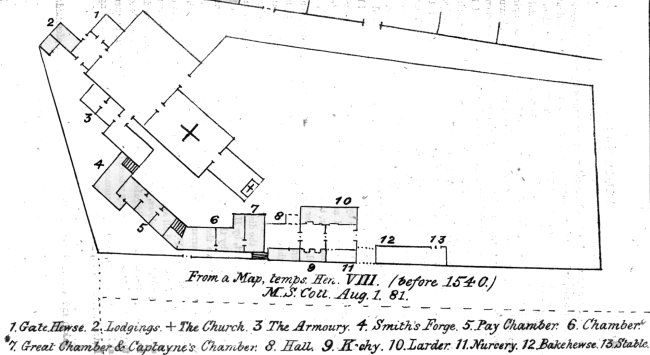
In deciding where to site the trenches the team was aware that in the late 16th century Elizabeth I had ordered a major upgrade to the fortifications surrounding the original town of Portsmouth and included in this was the construction of an imposing house to act as the official residence of the Governor. This house was sited directly over a part of the original hospice which would have been largely demolished, but it was hoped that some of it's buildings would have been incorporated into the new Government House. For this reason the first trench was dug in the area of the stables and the bakehouse (nos. 12 and 13 on the plan above). By mid afternoon on the first day a large rectangular area had been opened up, hitting archaeology only a foot below the surface.

Initially the archaeology in this trench seemed confusing and very soon it was decided to extend it. In addition a second trench was opened over the area thought to be where the hall of the hospice (no. 8 on the plan above) should be located. It was also important to try and locate the wall that would have surrounded the whole complex and so the trench was long and narrow (1 metre wide). Again, archaeology was struck within a foot of the surface, but this time substantial walls were located; three of them in fact, parallel and very close together.

Day Two began with both trenches being extended. Trench One remained confusing and so a small team was left to work on it for the remainder of the day as resources were concentrated on Trench Two. This soon revealed a fourth parallel wall and the beginnings of a paved area. Around midday the historians in the team were suggesting that there may have been a cloister associated with the Domus Dei, the theory being that although there was no historical evidence for a cloister in this instance almost all of the known hospices did have one. Trench three was therefore started in an area to the south of the Garrison Church across what was later to become the Parade Ground, primarily to see if the Pay Chamber (No.5 on the plan above) still existed but also to check for the possible presence of a cloister.
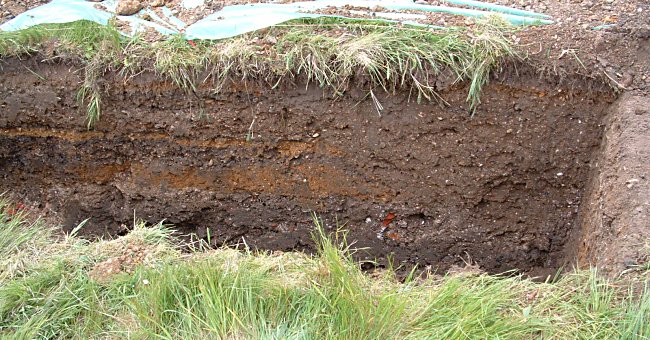
Trench Three yielded one piece of stone which may have been part of a medieval doorway, but it was completely out of context. The rest of the trench consisted of compacted gravel and after going down nearly 2 metres without hitting archaeology it was decided to terminate work on the trench. In the meantime, Trench Two had been further extended to reveal a major wall that cut through the now fully exposed paved area. The wall was plainly a later development as the paving close to it had been broken to allow it's construction. There was some speculation that this later wall must have been a part of Government House, a reasonable deduction given the available evidence for the location of its walls.
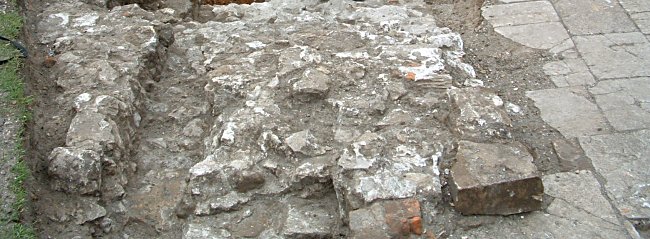
During the afternoon on Day Two a group of pupils from Portsmouth Grammar School arrived and were taken on a conducted tour of the site, followed by some hands-on experience of using the Ground Penetrating Radar machine. This was followed by a move to the nave of the Garrison Church where re-enactors and a Time Team specialist historian spoke to them about life as a pilgrim in medieval times.
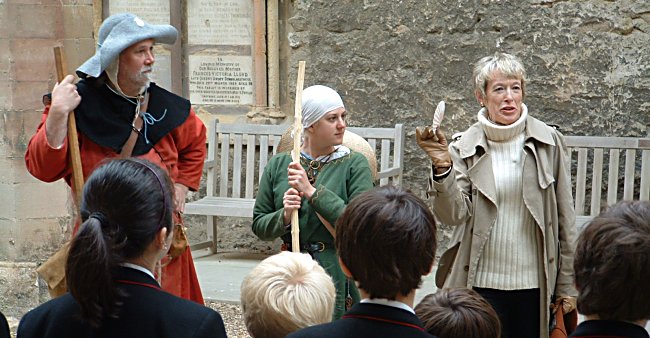
At the end of Day Two the members of Time Team were of the opinion that the paved area unearthed in Trench Two was probably not part of the hospice, but at the other end of the trench they were happy that the boundary wall had been identified. Archeaologists then excavated the area immediately outside the hospice and landed on the original road that ran from the modern day Pembroke Road towards the sea. This road was in effect an extension of St. Nicholas Street and was probably similarly named.
Day Three began with the rain falling but fortunately it petered out after a couple of hours. It seemed as though the Team members had changed their minds about the paved area over night and it was now considered to have been part of the original hall of the hospice, though the paving slabs themselves would have been renewed on several occasions. Work then began to find the limits of the hall and to this end Trench Two was extended again. They also decided to check what remained of Government House in an area to the south-east of the church that they had identified as the main entrance. Trench Four was restricted to a few square metres which again yielded archaeology a few inches beneath the surface. As this only consisted of a thin, compacted chalk layer the Team decided to record it then excavate on down. After a further metre, in which no archaeology was encountered they concluded that the foundations had been completely robbed out and they closed the trench.
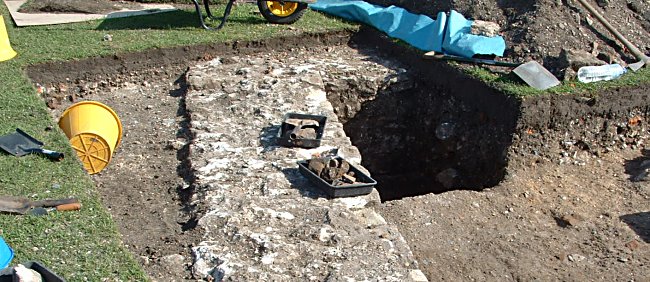
In the afternoon of Day Three the final confirmation that the Team were looking for came to light. In a part of Trench Two they had excavated what was thought to be the northern wall of the hospice Hall, and found two pieces of pottery which were declared to be of 13th Century origin by the Team's pottery expert. This was the crucial evidence that they had been looking for and they could now declare that they had indeed discovered a part of the original hospice.
[Please note: all deductions in this article are those of the author and do not necessarily represent the views of the Time Team]
Tim Backhouse